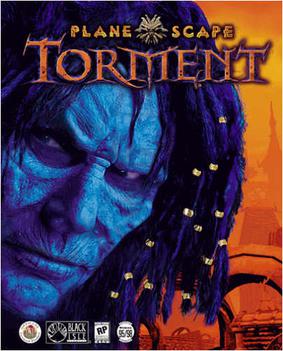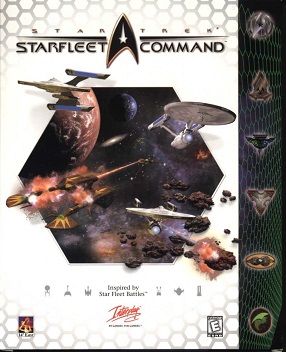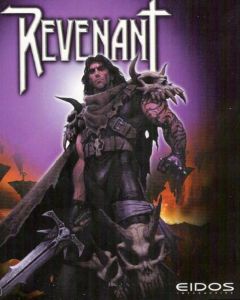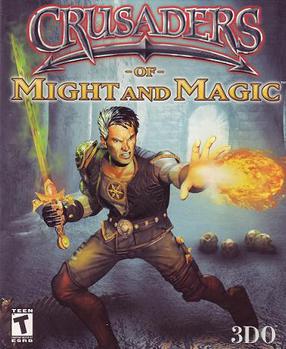
Planescape: Torment is a 1999 role-playing video game developed by Black Isle Studios and published by Interplay Entertainment for Windows. The game takes place in locations from the multiverse of Planescape, a Dungeons & Dragons (D&D) fantasy campaign setting. The game's engine is a modified version of the Infinity Engine, which was used for BioWare's Baldur's Gate, a previous D&D game set in the Forgotten Realms.

Star Trek: Starfleet Command is a computer game based on the table-top wargame Star Fleet Battles. It was developed by 14° East and Quicksilver Software and published by Interplay Entertainment. It was released in 1999 for Microsoft Windows. It simulates starship operations, ship-to-ship combat, and fleet warfare in the Star Trek universe. An expanded version was released in 2000 titled Star Trek: Starfleet Command - Gold Edition. It includes the latest patch and all the missions that were downloadable from the official website.

Icewind Dale is a role-playing video game developed by Black Isle Studios and originally published by Interplay Entertainment for Windows in 2000 and by MacPlay for the Macintosh in 2002. The game takes place in the Dungeons & Dragons Forgotten Realms campaign setting and the region of Icewind Dale, and uses the 2nd edition ruleset. The story follows a different set of events than those of R. A. Salvatore's The Icewind Dale Trilogy novels: in the game, an adventuring party becomes enlisted as a caravan guard while in Icewind Dale, in the wake of strange events, and eventually discover a plot that threatens the Ten Towns of Icewind Dale and beyond.

Darkstone: Evil Reigns is an action role-playing video game developed by Delphine Software International for Microsoft Windows and PlayStation. In 2014, the French publisher Anuman Interactive launched a remake available on iPad, iPhone and Android, with the cooperation of the original game's author Paul Cuisset.

Fallout 2: A Post Nuclear Role Playing Game is a 1998 role-playing video game developed by Black Isle Studios and published by Interplay Productions. It is a sequel to Fallout (1997), featuring similar graphics and game mechanics. The game's story takes place in 2241, 80 years after the events of Fallout and 164 years after the atomic war which reduced the vast majority of the world to a nuclear wasteland. The player assumes the role of The Chosen One, the grandchild of the first game's protagonist, and undertakes a quest to save their small village on the West Coast of the United States.

Age of Wonders is a 1999 turn-based strategy game co-developed by Triumph Studios and Epic MegaGames, and published by Gathering of Developers.

Delta Force 2 is a tactical first-person shooter video game developed by NovaLogic and released in 1999. It is the second game in the Delta Force series and was followed by Delta Force: Land Warrior one year later. The game was re-released in 2009 on Steam.

Sacrifice is a real-time strategy video game published by Interplay Entertainment in 2000 for Microsoft Windows platform. Developed by Shiny Entertainment, the game features elements of action and other genres. Players control wizards who fight each other with spells and summoned creatures. The game was ported to Mac OS 9.2 in 2001.

Revenant is an action role-playing video game produced by Cinematix Studios and released in 1999 by publisher Eidos Interactive.

Disciples: Sacred Lands is a turn-based PC strategy game published by Strategy First in 1999. Set in a fantasy world known as the Sacred Lands, it depicts a battle for dominance between the races of the world of Nevendaar. In 2001, an expanded version of the game was released titled Disciples: Sacred Lands - Gold Edition, which added 25 new scenarios.

Crusaders of Might and Magic is a third-person action/RPG video game developed and published by 3DO's Austin, Texas studio (PlayStation) and Redwood Shores studio (PC). Different versions of the game were released for both Microsoft Windows and the PlayStation. The protagonist Drake was voiced by veteran voice actor Kevin Conroy.

Interstate '82 is a vehicular combat video game developed and published by Activision for Microsoft Windows in 1999.

European Air War is a combat flight simulator developed and published by MicroProse and published for Microsoft Windows in 1998. It is a sequel to 1942: The Pacific Air War. It simulates the Battle of Britain, and the Allied Air offensives in Western Europe during World War II in 1943–1945.

Baldur's Gate is a role-playing video game that was developed by BioWare and published in 1998 by Interplay Entertainment. It is the first game in the Baldur's Gate series and takes place in the Forgotten Realms, a high fantasy campaign setting, using a modified version of the Advanced Dungeons & Dragons (AD&D) 2nd edition rules. It was the first game to use the Infinity Engine for its graphics, with Interplay using the engine for other Forgotten Realms-licensed games, including the Icewind Dale series and Planescape: Torment. The game's story focuses on a player-made character who travels across the Sword Coast alongside a party of companions.

Gorky 17 is a turn-based tactics tactical role-playing video game developed by Polish studio Metropolis Software and published by Monolith Productions for Microsoft Windows in 1999. The game was later ported to Linux by Hyperion Entertainment and published by Linux Game Publishing in 2006. The AmigaOS 4 version was released in 2015.

Mortyr 2093-1944, also known as simply Mortyr, is a first-person shooter computer game published by Interplay and developed by Polish developer Mirage Media and released in 1999. One of the earlier Polish developed first-person shooters for Microsoft Windows, the game follows a son of a scientist transported back in time to World War II to avert the Axis victory and features levels set both in World War II and the future. The game received unfavorable reviews at its launch, with the game garnering some positive coverage from the Polish video game press and widely panned abroad.

Jane's World War II Fighters is the 1998 combat flight simulation video game. Set in the European theatre of operations during World War II, it is part of the Jane's Combat Simulations franchise. The game was considered a commercial failure, and contributed to the end of the Jane's Combat Simulations line.

M.A.X. 2: Mechanized Assault & Exploration, or simply M.A.X. 2, is a 1998 hybrid real-time/turn-based strategy video game developed and published by Interplay Productions. It's a sequel to Mechanized Assault & Exploration.

FIFA 2001 is a football simulation video game and the sequel to FIFA 2000. It was succeeded by FIFA Football 2002. It features Paul Scholes on the UK cover and Ben Olsen on the North American cover. The game's Spanish cover features Gaizka Mendieta on it. It was released on 31 October 2000 for Microsoft Windows and PlayStation, and on 24 November 2000 for PlayStation 2 as a launch title in Europe. The PlayStation 2 version was originally slated for release in the U.S. on 7 November, before it was delayed to 28 November. A Game Boy Color version was planned but cancelled.

Invictus: In the Shadow of Olympus, also known as simply Invictus, is a video game developed by Quicksilver Software, Inc. and published by Interplay for Windows in 2000.



















